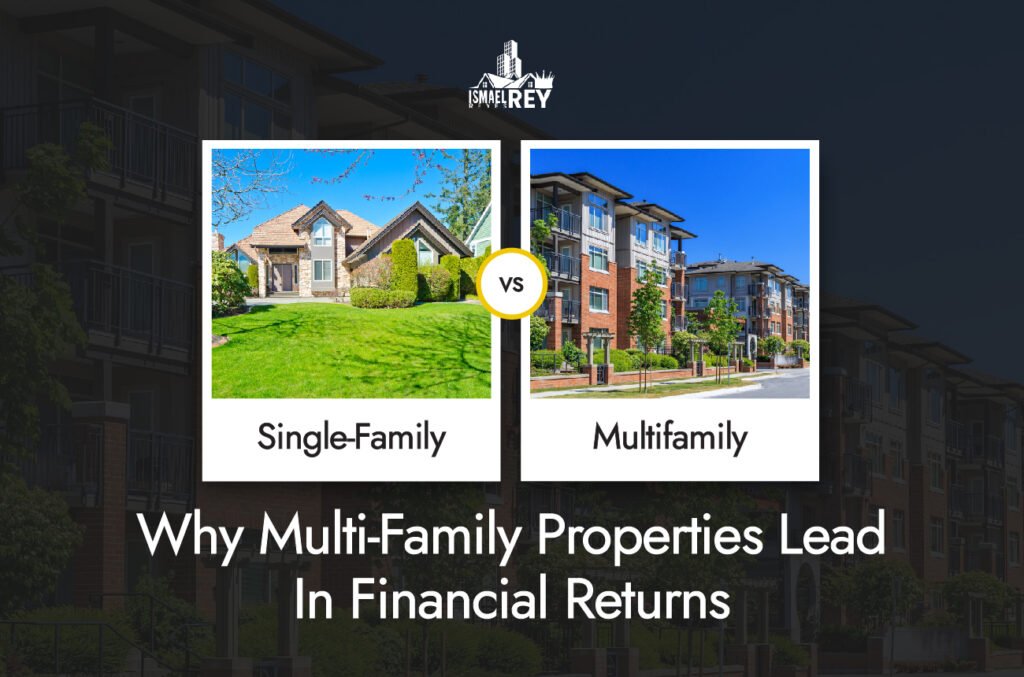
Deciding between single-family and multi-family property investments is a pivotal choice for both new and experienced investors. While both options have their place in real estate portfolios, multi-family properties consistently demonstrate superior financial advantages that make them the preferred choice for building long-term wealth. This comprehensive guide explores why multi-family investments often deliver better returns, reduced risk, and greater scalability for your investment goals.
Location Advantages: Multi-Family Properties Win in High-Growth Markets
The location factor strongly favors multi-family investments, as these properties are strategically positioned in the most economically dynamic areas.
Urban Growth Centers Drive Superior Returns
Multi-family properties are predominantly located in urban and suburban growth corridors where economic activity, job creation, and population growth are strongest. These high-demand locations translate directly into:
- Higher rental yields due to increased tenant demand
- Stronger appreciation rates driven by economic growth
- Greater rental rate growth in expanding markets
- Superior exit opportunities with larger buyer pools
Economic Proximity Creates Competitive Advantages
Multi-family properties benefit from prime locations near:
- Major employment centers and business districts
- Public transportation hubs that attract quality tenants
- Shopping, dining, and entertainment amenities
- Healthcare and educational facilities
Single-family homes, while offering suburban tranquility, are often located in areas with slower economic growth and limited rental demand, resulting in lower yields and reduced appreciation potential.
Population Density Equals Profit Density
The higher population density surrounding multi-family properties creates a natural competitive moat. With more potential tenants in the immediate area, multi-family properties enjoy:
- Shorter vacancy periods
- Greater tenant selection options
- More stable rental income streams
- Reduced marketing costs for tenant acquisition
Market Research: The Big 3 Minus R Favors Multi-Family
When applying “The Big 3 Minus R” criteria (Population Growth, Economy, Jobs, Minus Risk), multi-family properties consistently outperform:
Population Growth: Multi-family properties are positioned in high-growth urban areas attracting young professionals and families seeking rental flexibility.
Economy: Urban markets with multi-family properties typically have more diversified economies, reducing dependence on single industries.
Jobs: Multi-family locations correlate with job growth centers, ensuring sustained tenant demand.
Minus Risk: While political risk exists everywhere, multi-family properties in established urban markets face lower overall risk due to economic diversification.
For detailed market analysis techniques, reference: MI Real Estate – #Multifamily Investing – The Big 3 Minus R Criteria for Selecting Target Markets
Investment Capital and Financing: Multi-Family Offers Superior Access
Lower Barrier to Entry Through Syndications
Multi-family syndications revolutionize real estate accessibility by allowing passive investment with significantly lower capital requirements. Instead of needing 25% down payment plus reserves for a single-family property, investors can participate in institutional-quality multi-family deals with investments starting at $25,000-$50,000.
Professional Underwriting and Due Diligence
Syndication teams provide professional-grade analysis that individual investors cannot match:
- Comprehensive market analysis
- Professional property inspections
- Detailed financial modeling
- Institutional-quality due diligence
Financing Advantages
Multi-family properties have access to superior financing options:
- Commercial loans with better terms for cash-flowing properties
- Agency debt (Fannie Mae, Freddie Mac) at competitive rates
- Professional guarantees eliminate personal liability concerns
- Non-recourse options protecting personal assets
Rental Income Potential: Multi-Family Delivers Superior Cash Flow
Diversified Income Streams Reduce Risk
Multi-family properties generate income from multiple units, creating a natural risk mitigation strategy. If one unit becomes vacant, the other units continue to generate revenue, maintaining a positive cash flow. Single-family properties face total income loss during vacancies.
Economies of Scale Maximize Profitability
Multi-family properties benefit from operational efficiencies:
- Shared maintenance costs across multiple units
- Bulk purchasing power for supplies and services
- Efficient property management with concentrated units
- Higher gross rental yields due to optimal unit mix
Professional Revenue Optimization
Syndication teams implement sophisticated revenue strategies:
- Market-rate analysis and optimization
- Value-add improvements increasing rents
- Ancillary income streams (parking, storage, amenities)
- Professional tenant screening reduces bad debt
Property Management: Professional Advantage
Scale Creates Efficiency
Multi-family properties require professional management, but this becomes an advantage rather than a burden:
- 24/7 professional oversight ensuring optimal operations
- Maintenance teams providing rapid response and cost control
- Leasing specialists minimize vacancy periods
- Accounting systems provide detailed financial reporting
Reduced Investor Workload
Passive multi-family investment eliminates the time-consuming responsibilities of single-family management:
- No middle-of-the-night maintenance calls
- No tenant screening and lease negotiations
- No property marketing and showing requirements
- No contractor coordination and oversight
Single-family property management, whether self-managed or through third parties, typically consumes significant investor time while reducing net returns by 10-15% through management fees.
Risk and Diversification: Multi-Family Provides Superior Protection
Built-in Diversification
Multi-family properties offer inherent diversification advantages:
- Multiple income streams from various units
- Tenant diversity reduces reliance on single lessees
- Market resilience through varied tenant demographics
- Geographic efficiency concentrates investment in proven markets
Economic Cycle Resilience
Multi-family properties demonstrate superior performance across economic cycles:
- Recession resistance as people prioritize housing over homeownership during downturns
- Inflation protection through regular rent adjustments
- Supply constraints in many markets support rental demand
- Demographic trends favoring rental housing among millennials and Gen Z
Professional Risk Management
Syndication teams implement institutional-level risk management:
- Comprehensive insurance coverage
- Legal compliance and regulatory management
- Financial reserves for capital improvements
- Professional asset management strategies
Exit Strategy and Tax Advantages: Multi-Family Excels
Strategic Exit Planning
Multi-family syndications typically implement 3-7 year business plans with clearly defined exit strategies:
- Value-add improvements increase property value
- Market timing optimization for maximum returns
- Professional sales process accessing institutional buyer markets
- Investor communication throughout the hold period
Superior Tax Benefits
Multi-family investments offer enhanced tax advantages:
- Accelerated depreciation through cost segregation studies
- Passive loss benefits for qualifying investors
- 1031 exchange opportunities for tax-deferred growth
- Opportunity Zone benefits in qualifying markets
- Professional tax planning through syndication structures
Historical Performance Data
Multi-family properties demonstrate superior long-term returns:
- Higher average annual returns compared to single-family rentals
- Better risk-adjusted returns due to diversification
- Superior appreciation in high-growth markets
- More predictable cash flow patterns
Frequently Asked Questions
Q: Is multi-family investing only for experienced investors? No. Syndications make multi-family investing accessible to new investors through passive investment opportunities with professional management and lower minimum investments.
Q: What returns can I expect from multi-family investments? While returns vary by market and strategy, multi-family syndications typically target 15-25% IRR with 2x+ equity multiples over 3-7 year hold periods, significantly outperforming typical single-family rental returns.
Q: How much money do I need to start investing in multi-family properties? Multi-family syndications often have minimums starting at $25,000-$50,000, making them accessible compared to the $100,000+ typically required for single-family investment properties.
Q: Are multi-family properties riskier due to their complexity? Multi-family properties are actually less risky due to income diversification, professional management, and economies of scale. The complexity is handled by experienced syndication teams.
Q: How do I evaluate multi-family investment opportunities? Focus on the syndication team’s track record, market fundamentals, deal structure, and alignment of interests. Professional teams provide comprehensive investment summaries and financial projections.
Q: Can I invest in both single-family and multi-family for diversification? While diversification has benefits, concentrating on multi-family investments often provides better risk-adjusted returns due to the inherent diversification within multi-family properties themselves.
Conclusion
The evidence consistently points toward multi-family real estate as the superior investment choice for building long-term wealth. Through syndication opportunities, investors gain access to institutional-quality properties with professional management, diversified income streams, and superior growth potential. While single-family properties may seem simpler, multi-family investments offer better returns, reduced risk, and greater scalability for serious wealth building.
The choice between single-family and multi-family investing isn’t just about preference—it’s about maximizing your financial potential. Multi-family properties deliver the combination of cash flow, appreciation, tax benefits, and risk mitigation that serious investors need to achieve their financial goals efficiently and effectively.
Ready to start your passive real estate investment journey? Explore Opportunities Now
Partnering with a real estate investment consultant like Ismael Rey Reyes ensures your journey into real estate investing is guided, strategic, and stress-free. Reach out today to start building your real estate portfolio with confidence!


